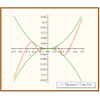Analysis Seminar
Bifurcation of solutions of a path of nonlinear equations from a trivial branch of solutions has, since the time of Euler, been widely studied. The strategy of so-called linearized bifurcation is to linearize the equation about the trivial solution and deduce bifurcation results for the path of nonlinear equations from properties of the path of linearizations. We consider this strategy for analyzing bifurcation of critical points. More precisely, let $H$ be a real Hilbert space and consider $\psi\colon R\times H\to R$ a path of $C^2$ functionals with the property that for all $\lambda, u=0$ is a critical point of $h\mapsto \psi(\lambda,h),$ that is, $h=0$ is a solution of the equation
$$\nabla_h\psi(\lambda,h)=0.$$
To study bifurcation of nonzero critical points, look at the second variation of $h\mapsto \psi(\lambda,h)$ at $u=0$ to obtain a path $\lambda\mapsto L(\lambda)$ of bounded, symmetric operators on $H$, and assume each $L(\lambda)$ is Fredholm. To this path there is an associated concept of spectral flow and we describe how nonzero spectral flow forces bifurcation of nonzero critical points. We do this first in finite dimensions and also consider examples arising as differential equations.
